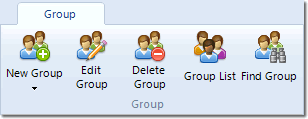
Groups
Groups allow you to categorize your mailing list into different areas of interest. If you enter each address into your database with a different group, then you can easily send a newsletter to just the users in a particular group and can allow list members to send messages to others in the same group. For example, if you are a company with a range of products, you may have a group for each product and assign customers to the product groups they have purchased so you can easily send out newsletters only to the relevant contacts.
Creating and Editing Groups
Groups allow you to categorize the members of your mailing list into their area of interest. You can then easily send only to interested members and assign options as relevant.
You can create and edit groups by selecting File > Options, "Groups" tab or by selecting Groups mode in the main window and using the Groups menu.

For each group you can specify the following details:
General
Group Name: The identifier for the group within MailList King and used by mailing list commands (e.g. SUBSCRIBE Some_Group). Groups cannot contain special characters such as commas and it is recommended that they do not use spaces
Description: If you allow use of the GroupInfo command, the description is returned to users inquiring about the group
Statistics: Information about the membership and sending to this group
Members can join this group: Uncheck this setting to lock the group so that new users cannot be added. You can use this option to create private groups to which only only the Administrator can add users (any other attempts to subscribe will be blocked and added to the Error list)
Members can send to this group:
If you have enabled member
sending, you can uncheck this option for any groups for which member
sending is not permitted
Messages
You can specify the messages that are sent automatically when members perform actions such as subscribing or removing themselves under Fi > Options, Automated Emails. These settings allow you to specify custom handling for each of your groups, for instance creating a custom welcome message or disabling sending or double opt-in for a specific group.
Acknowledgement Messages: Disable or customize the Subscribe or Unsubscribe Acknowledgement
Welcome Message: Customize the message that is sent the first time a user joins a particular group. Click the Delayed Messages button to send multiple messages when a user joins a group, e.g. send a reminder after 30, 60 and 90 days.
Double Opt-In and Opt-Out: If you require your users to confirm subscribes/unsubscribes with Double Opt-In you can use disable or customize sending for the current group
Note: If you select "Group Detail"
mode (under "Statistics" in the main window)then enable the
"Group Settings" column view, then
you can see at a glance which groups have custom messages and/or sending
disabled.
History
A log of all activity that has occurred in this group.
|
Group nesting allows you to categorize your groups within other groups in the same way folders can be arranged in Windows Explorer. Once you enable the group nesting option all group display windows allow you to click on a group name, drag it and drop it onto another group. |
|
Other Group Options
When no group is given (e.g. an e-mail is received with just the subject "SUBSCRIBE") the group specified here will be used
What occurs when a user sends a subscribe request but specifies a group that does not exist. You can choose between adding the user to the Errors List ("Processing Errors" mode under "History " in the main window), prompting to specify a group, automatically creating the group or using the default group
What occurs when a user sends a subscribe request but specifies a group that does not exist. You can choose between adding the user to the Errors list ("Processing Errors" mode under "History " in the main window), prompting to specify a group or using the default group
What occurs when a user sends a unsubscribe request but specifies a group that does not exist. You can choose between adding the user to the Errors list ("Processing Errors" mode under "History " in the main window), prompting to specify a group or completely removing the user from the mailing list
What occurs when a user sends a unsubscribe request but specifies a group that does not exist. You can choose between adding the user to the Errors list ("Processing Errors" mode under "History " in the main window), prompting to specify a group or completely removing the user from the mailing list
See Also